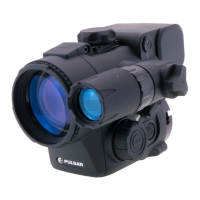14
Peculiarities of CCD array
Sony CCD arrays employed in Pulsar digital night vision devices, feature high quality. However certain
pixels (or groups of pixels) with increased luminosity (lighter or darker) are allowed. These defects can be
seen when conducting observation not only in the nighttime but in the day time too, especially if Sum Light™
function is active. Presence of light and dark pixels and other minor defects of a CCD array (up to 4%) are
acceptable in accordance with regulations of the company SONY.
Visibility on the screen of light pixels also depends on the type of CCD array, heating temperature during
operation.
Listed below are some potential problems that may occur when using the scope.
Carry out the recommended checks and troubleshooting steps in the order listed.
Please note that the table does not list all of the possible roblems. If the problem
experienced with the scope is not listed, or if the suggested action meant to
correct it does not resolve the problem, please contact the manufacturer.
15
PWR
12
16
22
• In order to remove the monocular, move the lock (12) sideways and turn
the monocular clockwise until it clicks.
• Pull the pins out of the monocular’s grooves and remove the monocular
carefully.
It is recommended that you inspect the riflescope before every use. Make
sure to check for the following:
Visually inspect that the unit is free from any physical damage; cracks,
dents or signs of corrosion which may disqualify it from proper use.
Check the sturdiness and proper fit of the mounting system.
Ensure that the objective lens and the IR illuminator are free of cracks,
grease spots, dirt, water stains and other residue before use.
Visually inspect the condition of the battery and the battery compartment;
the battery should be free of electrolyte and oxidation residue, especially
where the battery makes contact with metal.
Verify the proper operation of the encoder, brightness adjustment knob
and control buttons.
Verify the smoothness of the objective lens focus knob.
•
•
•
•
•
•
Technical maintenance should be done no less than twice a year, and is
comprised in the following steps:
Clean the outside metallic and plastic surfaces from dust, dirt and
moisture; wipe the scope with a soft lint free cloth.
Clean the battery compartment's electric contact points using an oil-free
solvent.
Inspect the eyepiece lens, the objective lens and the IR illuminator and
gently blow off any dust and sand, and clean using lens cleaner and a
soft cloth; see section entitled “GUIDELINES FOR OPERATION”.
•
•
•
Always store the unit in its case in a dry, well-ventilated space. For
prolonged storage, remove the batteries.
The attachment will not
turn on.
With a crisp image of the
reticle, the image of the
observed target that is at
least 30 m away is
blurred.
The aiming point shifts
after firing rounds.
The attachment will not
focus.
The wireless remote
control does not respond.
Barely visible texture
which does not hinder
detection range or
efficiency of observation
can be noticed on the
display after the built-in
laser IR Illuminator is
activated.
Batteries have been wrongly
installed.
Oxidized contact points in the
battery compartment due to “leaky”
batteries or contact points
becoming exposedto a chemically-
reactive solution.
The batteries are empty.
Dust and condensate are covering
the outside optical surfaces of the
attachment or the daylight sight.
The sight is not mounted on the
rifle securely.
A different type of cartridges is
used.
Wrong settings.
Remote control is not activated or
wrongly activated.
Battery is low.
This is normal for eye safe laser IR
Illuminators.
Reinstall the batteries with the correct polarity
orientation.
Clean the battery compartment, focusing on the
contacts.
Install fresh batteries.
Clean the lens surfaces with a blower and soft
lens cloth. Let the attachment dry by leaving it
in a warm environment for 2-3 hours.
Check that the sight has been securely
mounted, make sure that the same type and
calibre cartridges are being used as when the
sight was initially zeroed; if your sight was
zeroed during the summer, and is now being
used in the winter (or the other way round), a
small displacement of the aiming point is
possible. Check the aiming point (section 9).
Adjust the sight according to the instructionsset
forth in the Section 8 “Operation” and check
the surfaces of the eyepiece and objective
lenses and clean them if necessary from dust,
condensation, frost, etc; to prevent fogging in
cold weather, apply a special anti-fog solution.
Activate the remote according to instructions in
section 10.
Install a new CR2032 battery.
problem
possible cause(s) corrective action

